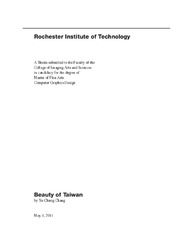| dc.description.abstract | The term "Multimedia" refers to not only the materials used in creating art, but also the devices used for presenting the content. In the present time, artists can practice computer softwares as the media. They use audio and video tracks to display artwork. Various formats of technological or digital multimedia enhance the user's experience in entertainment or art, and transcend everyday experience.
"Beauty of Taiwan", my MFA Thesis, is a Flash-based program which offers users interactivity to control the way to view art piece as used in video games. This program allows the presented film, made from my pencil drawings on the images of Taiwan, to be affected by the viewer's movements. Starting from when he/she first enters the affected zone situated in front of the screen, the program detects his/her initial location, and the film starts playing depending on his/her followup movements.
The opening has a sequence of images flowing in from either side of the screen, according to where the viewer enters the affected zone in relation to the screen. If the viewer enters the center of the zone, or if more than one viewer comes in from both sides at the same time, the film starts playing from the center of the screen. If no one is in the zone, an animated logo is set to loop as a screen saver.
Setting up a camera that collects proper amount of information is very critical. Through Flash, I'm able to locate viewer's movements. They are caught by the camera. That information is then transferred from the captured images and becomes the controller for the viewer to navigate through the film.
By having the interactivity between the viewer and the exhibited artworks, the brilliant artworks that used the traditional materials, are no longer just static images hung on the walls of museums, or of our own homes. In my project, the art piece now also attract instant conversations and simultaneous reactions between the creator and the audiences. The interactivity brings out the fun, communication and humanity to the creator, the audiences and the artworks. | en_US |

